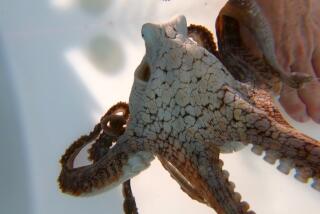PROPOSITION 132 : Banning of Gill Nets on Ballot
Recreational fishermen know all about gill nets. They call them indiscriminate, wasteful killers of marine life. They claim that gill nets deplete the sea of mammals, birds--and of the fish the anglers like to catch. To these fishermen, a law banning their use is the answer.
Commercial fishermen use gill nets to make a living or supplement their income. They consider the nets to be highly efficient, but there is a sense of discomfort about the controversy over their use.
The long-simmering fight between those who fish for sport and those who depend on the sea for their livelihoods may be decided by the outcome of Tuesdayâs vote on Proposition 132.
The initiative would amend the state Constitution to prohibit gill or trammel nets--one traps fish by the gills, the other entangles--within three miles of the coast from Point Conception to the Mexican border, and within one mile of the Channel Islands.
The nets are temporarily prohibited in portions of Northern and Central California. Passage of Proposition 132 would make that permanent.
The ban would go into effect Jan. 1, 1994. Commercial fishermen would be required to pay for permits--at successively higher annual prices--for use in the zone between Jan. 1, 1991, and Dec. 31, 1993. Compensation for the loss of their permits when the ban takes effect--a onetime payment based on the average annual sale of the fishermanâs catch--would come from the sale of $3 stamps required with the purchase of a one-year California sportfishing license.
Assemblywoman Doris Allen (R-Cypress), who sponsored the initiative, has been on a five-year crusade to do away with the gear she calls âdevastating, indiscriminate, wasteful and archaic.â She has failed twice in the Legislature.
Her financial support has come largely from the people who figure to gain from a gill net ban--those directly or indirectly related to the sportfishing industry. The contribution list--$461,628 to qualify the measure for the ballot--is loaded with the names of yacht owners and organizations with sportfishing interests.
Proponents of Proposition 132 deny claims by the commercial fishing industry that the intent is to take away the livelihood of the near-shore gill-netters so there would be more fish for the recreational fishermen.
âWe want fish for everybody in the future, for our kids, for their kids, for the commercial fishermen (who use less destructive gear),â said Charlie Davis, 62, a member of the Avalon Tuna Club.
Davis, a former commercial fisherman and party boat operator, points to the fate of the thresher shark, a powerful game fish with tremendous market value. It used to be heavily sought by sportfishermen, but now is caught incidentally and infrequently, many feel because of the gill net. Swordfish, once abundant around the Channel Islands and offshore, also has become scarce.
Gill and trammel nets are spread over an area like large volleyball nets, and are practically invisible when under water. The nets are banned by several states and by some countries. If they are banned in Southern California, the commercial fishing industry says, the livelihoods of thousands of fishermen would be affected.
Officials of the California Gillnetters Assn. contend that consumers would pay significantly higher prices for fresh fish if Proposition 132 passes. Although 58% of the seafood consumed in the United States is imported, fresh fish such as halibut, sea bass and rockfish--all popular among recreational fishermen--will be more difficult to come by and therefore more expensive, they say.
State and federal biologists say there is no way to determine the exact impact of gill nets on fisheries. Records show that the annual halibut catch is divided about equally between commercial and recreational fishermen.
Aside from the resource question, gill net supporters must deal with what is being cast as a moral issue--incidental killing of marine mammals and birds.
California Department of Fish and Game records show that more than 6,500 sea lions, harbor seals and harbor porpoises were killed in gill and trammel nets in 1986-87.
In 1987-88, the number of sea lions that drowned in gill nets in California totaled more than 4,000, which, critics say, points to a bleak future for a species that rebounded under the protection of the Marine Mammal Act of 1972. The American Cetacean Society has recorded 61 instances of California gray whales becoming entangled in gill nets between 1980-89; 20 whales were known to have died.
âWeâre seeing an average of 5% of the animals found anywhere have pieces of net attached to some part of their bodies,â said Peter Howarth, director of the Marine Mammal Center in Santa Barbara.
Department of Fish and Game Director Pete Bontadelli said department biologists have given him no reason to believe any of the species targeted by the gill nets are in serious trouble and that commercial gill net fishermen and the sportfishermen should have an equal share of marine resources.
Biologist Maria Vojkovich, after observations on 1,558 near-shore gill net vessels operating in Southern California, determined that about 80% of the species taken were either sold for consumption, utilized as bait for a trap fishery, or returned alive. A recent tagging study involving California halibut determined that of the fish returned alive, 11% survived.
These results contradict claims by the Committee to Ban Gillnets that â72% of everything caught in gill nets have no economic value to commercial fishermen, that 7 of 10 species are unmarketable--yet they still die.â
More to Read
Sign up for Essential California
The most important California stories and recommendations in your inbox every morning.
You may occasionally receive promotional content from the Los Angeles Times.










